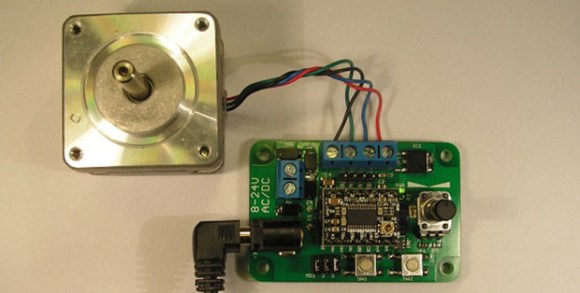
The Stepstick and Pololu motor drivers are the heart of just about every Reprap electronics board, but they can go bad. The usual way of testing these things is to rig up a microcontroller on a breadboard, grab some cables, and wire something up. [Ken]’s Easy Stepper Motor Controller is a much simpler solution to the problem of testing these drivers and could, with a bit of practice, be constructed on a single-sided homebrew PCB.
The Easy Stepper Motor Controller is a very simple board with connections to a motor, a power supply, and headers for a single Pololu or Stepstick motor driver. Two buttons and a pot control the rotation of the motor with the help of an ATtiny10, and jumpers for up to 16x microstepping are right there on the board.
There’s a video after the break showing what this stepper motor driver driver can do. It’s not much, but if you’re just testing a driver, it’s all you need.















To who what? Rig up a microcontroller on a breadboard? All you need to test a stepper driver is a clock signal to the step input. Oh and powering the thing up too. A 555 timer circuit does just fine. Why do you people cast about for the most complex solution all of the time?
A 555? Yeah, that’ll do the trick, but it is handy to eventually have some pulse generators lying around for such things.
“You people”?!!?
Racist.
Kidding aside. Some might find that math and circuit tuning for the 555 is slightly more trouble than slapping an existing/known circuit and code at it. Plus there’s the shopping. Crazy as it may sound, lots of people have micros coming out the rectum but no 555s in their stock of parts.
But when considering etching and soldering boards, you have a point: slapping a 555 on a breadboard would be easier, cheaper, and more efficient.
Buuuuut a micro has lots of room for customization. The whole kit, as is, could be put to use in another stepper project.
I’m reading this as a stepper motor tester, not a stepper motor driver tester:
“The Motivation
The reason for this project was my frustration over how much it takes to just test a simple stepper motor.
To test a stepper motor you usually need some kind of MCU most likely a Arduino, your breadboard, cables, some kind of driver and other components.
When you got all that assembled you still need to write and upload some code to run the driver, but before you can do that you also need to find your USB cable and if the code doesn’t work you have to debug it.
All this can easily take an hour but with the Easy Stepper you just plug in your stepper motor and whatever power supply you have and you are ready to go.”
The complaints about having to write code don’t really make sense, as this solution still requires the same.
Translation: He wants to sell you his product as a solution.
To test a stepper motor all you need is a battery. You can even determine the phase of a motor with just a battery. The Internet is littered with tutorials how to do it. Although if you have a pair of identical stepper motors it is easy to test a stepper motor. Just connect all of the same wires together between both motors and spin one motor shaft with your fingers, if the other motor spins in sync then both motors are OK.
Now you don’t have to *waste* that extra 20 minutes to find the power supply and hunt for a free wall outlet. Don’t even pay a cent!
Why that this whole thing sounds like the sales pitch of those cable commercials?
This looks like me to be gloating over having the linear stepper actuators I could never find ):-|
– but always wanted –
I make my own dc servos now…
His name not Ken, but Kenneth! – His nick is “Weiss” btw.
I want a circuit I can use to manually operate a 1600 oz-in stepper motor on the Z axis of my mill. I can put hand cranks on the table for manual operation but there’s no way to manually adjust the quill up and down.
For people who sell stepper motors for a living, this is an invaluable tool to pull up in front of a customer to show that the motor is functional.
The idea that you have to show to your customer that your product is actually functional seems a bit odd, especially for something as robust as a stepper motor.
Yeah I’m sure it never happens. :P
Oh, I’m sure it happens, but I doubt it has a measurable impact on the total sales of stepper motors.
It’s both a stepper motor tester and a stepper motor driver tester.
It’s also a tool for when you are making any kind of device that includes a stepper motor or a toy to play with the stepper motor parts that you scavenged from some old equipment.
Use your imagination and creativity to make your own awesome stuff, not pick on others.
http://youtu.be/_i3zfBoEtVc